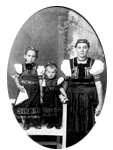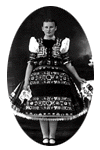In the cultural history of every nation an important role is played by folk culture as a bearer of the most expressive etnhnic specificities. From among the phenomena of folk culture a special status belongs to a traditional dress a folk costume which attracts the attention with its variety of forms and gayness of colour and decoration. It does attract lay admirers as well as artists and ethografhers. The former are fascinated owing to its variety of colour and picturesquennes, the latter owing to its declarative value as an expression of the culture and the way of living of the nation that created it. The frequent question to be asked is: what was the reason of the rise of such diversification and heterogeneity in the local forms of a traditional dress? The answer to this clear question, however, is neither simple nor unambiguous.

First of all we must bear in mind that what been saved from the traditional dress till the present days is a result of a long-term development. We do not know much about the oldest forms of the folk costume. We can envisage that the dress of both men and women had originally a shirlike shape. A certain part of the components of underwear and upper dress might have had the garments common both for men and women. It was only in the Middle Ages that the dress began to acquire the shape as we know it from the preserved documents from the end of the 18th century and the beginning od the 19th century. In the earliest period the traditional dress had been influenced to a gread extent by geographical environment and climatic conditions. These affected basic materials, flax or hempen linen, drapery or fur. In lowlands the dress was rather loose and linen while in mountaineous regions it was more tight-fitting and besides linen, made also of wool and fur. Hand in hand with the development of textile manufactures in the 18th century and industry in the 19th century beside home-spun textiles also industrial materials from cotton, wool and even silk began to be used. The new materials brought about the changes in forms and stylws of garments. The variety of materials was attended by gayety in colour. As an important moment was the spreading od embroidering technique in the 17th century and in the 18th century also a considerable ease to get coloured threads, not only cotton but also silk.
The inland as well as foreign embroidering motives together with advanced techniques formed a large scale of local styles fully applicable in decoration ef folk costumes. Beside embroidery, dominant especially in western and central Slovakia , also decorative weaving and application was used, distinctive in eastern Slovakia. The patterned blue and white print textile ensuing from the regional taste was also widely used. The elaboration of the local forms of folk costumes was significantly influenced by uneven economic development in idividual regions of Slovakia and also by increasing social differentiation of society. Economic prosperity of a region and welfare of people found the expression also in the folk costume.

In addition to this economic - social development line we must mention also a functional line. The protection of body is the basic function of a dress, including a folk costume. This demand was met by the garments of underwear and upper dress. At the same time the clothes are one of the cultural signs to distinguish man and a woman. Working clothes were purposefully and best adopted to natural conditions as well as to the working process. We can only presuppose that in bygone days the workong and festive clothes consisted of the same garments of the similar materials. Only gradually a special festive dress was formed differring from the working one in a new and more expensive material and more extensive and elaborate docoration. Thus decoration, high price and the style of clothes became charakteristic features of the festive dress. Its real form was further determined first of all by national, local and religious allegiance and then also by the age, condition and social status of the wearer. Besides the festive dress there was also a ceremonial dress, the basic function of which was to mark the role of an individual or a group of people in a respective rite. The wedding and mourning clothes were the most expressive.

The lay public is attracted especially by external visual side of the appearance. An expert in ethnography, on the other hand, is interested in the inner substatnce of the traditional dress based on the study of its composition from various garments, their cut, style and development. The terminology serves as an important source of identification of the traditional dress. It enables to classify the traditional dress in wider territorial, cultural and ethnic coherences. Following from the composition of basic garment components in Slovakia we can speak about 3 types of menīs dress and 2 types of womenīs dress. The menīs dress was made of linen, drapery and twill, that of women was divided into shroud and shirt-like forms.
The linen dress of men consisted of linen breeches, a shirt with wide sleeves and an apron. The drapery dress was formed from narrow trousers and a shurt with cuffs on the sleeves. The womenīs dress was composed of the shroud, a kind of a shirt without sleeves, camisole, skirt and an apron. The core of the shirt-like dress was formed by a long shirt with sleeves, skirt and an apron. Besides this wlementary dress of men and women there were also various bodices, waistcoats, blazers, bands and belts. Especially women often wore double or multiple basic garments, e.g. skirts. The upper dress included ddrapery coats, overblouses and various konds of fur coats. Women wore also kerchieves and sheets. The adjustment of head and footwear formed the inseparable part of clothing. The hairdo together with the cover constituted one whole as a characteristic feature of the traditional dress. Married women wore a bonnet and a kerchiev. Single girls were bare-deaded or wore a kerchief. Men, both married and single, always wore ahat and in winter a fur cap. As for traditional footwear it is first of all workong footwear which manifests the generic variety. In western and south-western Slovakia mule slippers were wotn, in central Slovakia drapery slippers and high drapery boots, especially in winter and in summer peasantīs shoes. In eastern Slovakia peasantīs shoes were predominant. As for Sunday best footwear top boots were worn in all Slovakia. At the beginning of the 20th century the stiched shoes became frequent and men began to wear hob-nailed boots.

From the aspect of basic types of clothes and footwear in Slovakia within the development in the last 2 centuries they were formed into 2 charakteristic wholes - clothes and footwear of the lowland region and clothes and footwear of the mountaineous region. There is not a sharp border between the two but a wide range of transition forms. In central European relations the complex of lowland regions connects Slovakia with the clothes of south-eastern Moravia, eastern Austria, Hungary, northern Jugoslavia and western Romania. The complex of mountaineous regions connects Slovakia with north-eastern Moravia, southern Poland, western Ukraine and northern and wastern Romania. In this common Carpathian elements are specially manifested. Thus the territory of Slovakia is crossed with the dividing line of 2 cultural regions of Europe - the lowland Pannonia basin and the mountaineous region of the Carpathians.
Ar the end of the 19th century and the beginning of the 20th century the existence and the development of the traditional dress undergoes considerable changes. On one hand local forms are being fully developed, on the other hand, we witness the first expresive marks of exinction. This process grows intensive, especially in the first half of the 20zh century. The development and the extinction od the traditional dress are influenced by 2 contradictory phenomena: proverty and property of various sections of the village population. The poor preferred more moderate and procurable clothes, the rich, on the other hand in clothing manifested treir possessions and social status. With regard to their dependent economic and social status and a closer link-up with the village and work in the family women ceased to wear the traditional dress much later than men. Men workong outside their village took off their traditional dess so that they would not doffer in new suuroundings and adapr themselves to working milieu, e.g. in a factory. One tred in the development, wspecially in womenīs gear tended to the creation of a galf-town form of a dress characteristic of daker colours, absence of traditional diversified decoration and a combination of townīs and traditional garments. The other trend, especially in menīs clothing led to a coplete replacement of a folk costume by the town dress. Only in some smaller regions dispersed all over Slovakia the development and wearing of the original traditional went on.

In our days the traditional dress - the folk costume has acquired a now social function. It has become a festive dress worn at various festivals and celebrations of personal or social character. Most often the folk costume can be met with at folklore festivals since the most significant form of its second life is its maintenance as a stage dress of country folklore groups and ensebles. Every year in summer folklore festivals and celebrations are organized nearly in every district of Slovakia. The Folklore Festival in Vychodna has a whole Slovak nature. Then there are folklore celebrations in Myjava, Detva, Kosice, Hrusov.
 Citizens of Hingarian nationality gave their festival in Zeliezovce, The Ukrainians in Svidnik. The dates in Jine and July are fixed and do not iterfere with each other. Exhibitions and expositions in museums also give the possibility to meet whit the riches and beauty of folk costumes. Among them the biggest and the most interesting is a permanent wxposition in the Ethnographical Institute of the Slovak Academy od Dciences and a Centre of Folklore Artistic Production are an exhaustless well of knowledge of the traditional dress in Slovakia.
Citizens of Hingarian nationality gave their festival in Zeliezovce, The Ukrainians in Svidnik. The dates in Jine and July are fixed and do not iterfere with each other. Exhibitions and expositions in museums also give the possibility to meet whit the riches and beauty of folk costumes. Among them the biggest and the most interesting is a permanent wxposition in the Ethnographical Institute of the Slovak Academy od Dciences and a Centre of Folklore Artistic Production are an exhaustless well of knowledge of the traditional dress in Slovakia.
